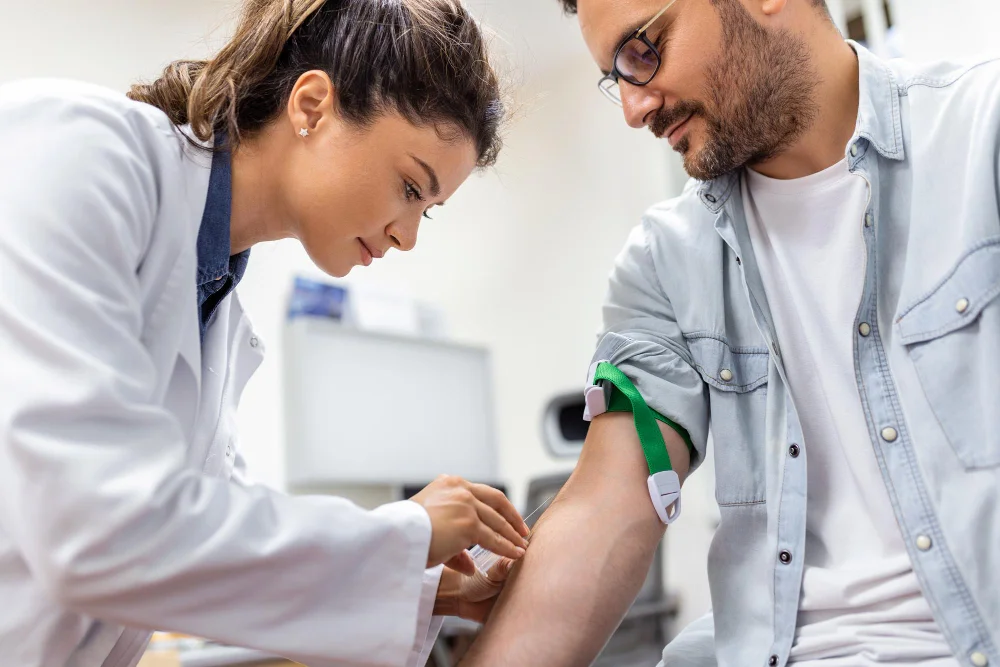Have you ever rolled up your sleeve after a blood test only to find a dark purple mark staring back at you?
It happens more often than you might think. I still remember the first time I noticed one — a deep blue bruise that seemed far too dramatic for a simple blood test. As someone who’s had more than a few medical check-ups and physiotherapy labs involving venipuncture, I decided to dig deeper into why bruising happens after a blood draw, and whether it’s ever something to be concerned about.
This article blends real experience, medical insight, and practical advice from experts to help you understand the science behind post-draw bruises, what’s normal, what’s not, and how you can speed up recovery.
Why Does Bruising Happen After a Blood Draw?
Bruising after a blood draw, medically known as post-venipuncture ecchymosis, occurs when blood leaks out of a vein into the surrounding tissue. The tiny puncture made by the needle sometimes allows blood to escape, especially if the vein was small, fragile, or moved slightly during the procedure.
Dr. Sarah Miles, a phlebotomist with over 12 years of experience at the NHS, explains: “A small bruise doesn’t necessarily mean something went wrong. It’s often just your body’s natural response to a very minor internal injury. The colour changes you see are simply blood being broken down under the skin.”
In simpler terms: a bruise is a small, harmless sign that your body is repairing itself.
Common Reasons You Might Bruise After a Blood Draw
While some people barely notice any marks, others seem to bruise every time. Here’s why:
1. Needle Angle or Technique
Even a skilled professional can accidentally nick a small blood vessel while removing the needle. If the needle passes through the vein rather than resting neatly inside it, minor bleeding can occur.
2. Fragile or Deep Veins
Older adults or people with certain conditions (like diabetes or dehydration) tend to have veins that are either fragile or not easily visible. This makes the process trickier and increases the risk of bruising.
3. Medications and Supplements
Blood thinners (like warfarin or aspirin) and even supplements like fish oil or vitamin E can make bruising more likely. Always inform your healthcare provider before any blood test if you’re taking these.
4. Poor Post-Draw Pressure
Leaving the bandage too early or not applying enough pressure on the puncture site after the needle is removed can let a small amount of blood seep out, causing a bruise.
5. Excessive Movement After the Test
Flexing your arm, lifting something heavy, or even bending the elbow too quickly can dislodge the small clot that forms to seal the vein, restarting minor bleeding beneath the skin.
What a Normal Bruise Looks Like (and When to Worry)
Most post-blood-draw bruises are small, tender, and fade over several days. They might go through a colour spectrum: from deep blue or purple to greenish-yellow before disappearing.
However, you should consult a doctor if:
- The bruise is very large or painful.
- There’s noticeable swelling or a lump at the site.
- You experience tingling, numbness, or difficulty moving your arm.
- You notice persistent bleeding under the skin.
- You bruise frequently or easily in other areas of your body.
Dr. Jonathan Reid, a haematologist at King’s College London, warns: “If bruising is accompanied by persistent swelling or warmth, it could indicate a hematoma or infection. It’s rare but worth getting checked.”
How to Heal Bruises After a Blood Draw
If you’re dealing with an unsightly mark, the good news is you can help it fade faster with a few simple remedies:
1. Apply a Cold Compress Immediately
Wrap an ice pack or chilled spoon in a clean cloth and apply it gently to the area for 10–15 minutes. This reduces blood flow and limits the size of the bruise.
2. Switch to Warm Compress After 24 Hours
Once the initial swelling subsides, gentle warmth can encourage blood circulation, helping your body clear out trapped blood cells.
3. Keep It Elevated (If Possible)
If the bruise is on your arm, rest it on a pillow or keep it slightly raised to minimise swelling.
4. Avoid Heavy Lifting or Pressure
Give your arm some rest for a day or two. Avoid carrying bags or doing strenuous workouts that could aggravate the area.
5. Try Natural Remedies
- Arnica gel or cream: Studies show that arnica can reduce bruise visibility faster.
- Vitamin K creams: Help strengthen capillaries and speed up healing.
- Aloe vera: Soothes and moisturises the skin, reducing tenderness.
6. Stay Hydrated and Eat a Balanced Diet
Foods rich in vitamin C (like oranges, strawberries, and bell peppers) and vitamin K (such as spinach and kale) help your body repair blood vessels efficiently.
Can You Prevent Bruising Next Time?
Absolutely. While bruising isn’t always avoidable, a few simple steps can reduce the risk dramatically:
- Tell the nurse about past bruising: They might use a smaller needle or choose a different vein.
- Stay still during the draw: Avoid sudden arm movements.
- Apply firm pressure afterward: Keep your arm straight and press on the site for at least 2–5 minutes.
- Avoid aspirin or supplements beforehand: Only if your doctor approves.
- Use your non-dominant arm: If possible, this reduces strain and accidental movement afterward.
The Science Behind Bruise Colours
Ever noticed how bruises change colour over time? It’s not random — it’s biochemistry in action.
When blood leaks under your skin, haemoglobin (the red pigment in blood) breaks down into different compounds:
- Red/purple: Fresh blood under the skin.
- Blue/dark purple: Oxygen levels drop.
- Green: Breakdown of haemoglobin into biliverdin.
- Yellow: Formation of bilirubin, signalling final healing.
Understanding this process can help you track healing naturally. Most bruises fade within 5–10 days, depending on your health and circulation.
Who’s More Prone to Bruising?
Some people are simply more susceptible:
- Elderly individuals (thinner skin, fragile veins)
- People on anticoagulant therapy (warfarin, heparin)
- Those with vitamin C or K deficiencies
- Individuals with bleeding disorders (like haemophilia or von Willebrand disease)
If bruising becomes a recurring issue, a simple blood clotting test can rule out any underlying conditions.
Real-World Example: When a Bruise Wasn’t Just a Bruise
A friend of mine, Emma, once noticed that her bruises were unusually large and slow to fade after routine blood tests. After consulting her GP, she discovered a mild vitamin K deficiency linked to her restricted diet. Once she adjusted her nutrition, the bruises became much less frequent.
It’s a good reminder that your body often sends subtle signals worth listening to.
Frequently Asked Questions
1. How long should bruising last after a blood draw?
Typically, 5–10 days. If it lasts longer or becomes painful, see a healthcare provider.
2. Can I exercise after giving blood?
Light walking is fine, but avoid heavy lifting or intense workouts for 24 hours.
3. Should I massage the bruise?
Avoid massaging it right after the draw; it can worsen bleeding. Once healing begins (after 24 hours), gentle circular motion can help with circulation.
4. Can bruising mean the nurse did something wrong?
Not necessarily. Even experienced phlebotomists can cause bruising due to vein fragility or patient movement.
5. When should I call a doctor?
If bruising is unusually painful, large, or accompanied by swelling, warmth, or persistent bleeding.
Key Takeaways
- Mild bruising after a blood draw is normal and harmless.
- Cold first, warm later — the simplest remedy.
- Stay hydrated and maintain good nutrition to support healing.
- Persistent or severe bruising warrants medical advice.
Final Thoughts
A bruise after a blood draw might look worrying, but in most cases, it’s just your body doing its job. The key is knowing what’s normal and when it might be something more. So, the next time you roll up your sleeve for a test, take a deep breath — a little bruise is often just part of the process.
Have you ever had a bruise that seemed unusual after a blood test? Share your experience or tips below — your story might help someone else feel at ease.
Read Also: Eat Oats and Banana Together for Weight Loss?
References:




